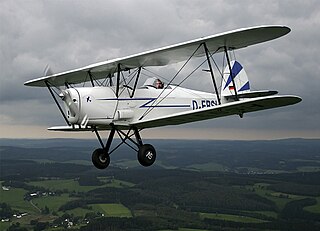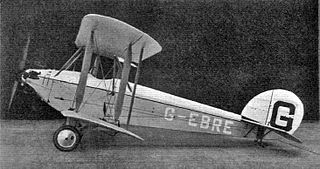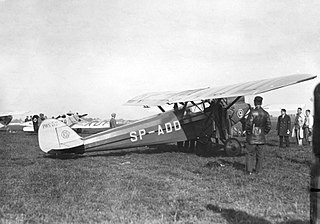
The de Havilland Gipsy Major or Gipsy IIIA is a four-cylinder, air-cooled, inverted inline engine used in a variety of light aircraft produced in the 1930s, including the famous Tiger Moth biplane. Many Gipsy Major engines still power vintage aircraft types.

The Ikarus Aero 2 was a piston-engined military trainer aircraft built in Yugoslavia in the years following World War II, although the design pre-dated the war.

The de Havilland DH.60 Moth is a 1920s British two-seat touring and training aircraft that was developed into a series of aircraft by the de Havilland Aircraft Company.

The DH.83 Fox Moth was a successful small biplane passenger aircraft from the 1930s powered by a single de Havilland Gipsy Major I inline inverted engine, manufactured by the de Havilland Aircraft Company.

The Stampe et Vertongen SV.4 is a Belgian two-seat trainer/tourer biplane designed and built by Stampe et Vertongen. The aircraft was also built under licence in France and French Algeria.

The PZL-5 was a Polish two-seat touring and sports aircraft of 1930 constructed and produced by the PZL.

The Avro Club Cadet was a 1930s single-engined British biplane trainer aircraft, designed and built by Avro as a development of the earlier Cadet. It was planned for private and club use and, unlike the Cadet, was fitted with folding wings.

The Bartel BM.4 was a Polish biplane primary trainer aircraft used from 1929 to 1939 by the Polish Air Force and Polish civilian aviation, manufactured in the Samolot factory in Poznań. It was the first plane of Polish design put into production.

The Blackburn L.1 Bluebird was a British single-engine biplane light trainer/tourer with side-by-side seating, built in small numbers by Blackburn Aircraft in the 1920s.

The de Havilland DH.75 Hawk Moth was a 1920s British four-seat cabin monoplane built by de Havilland at Stag Lane Aerodrome, Edgware.

The Caproni Ca.100 was the standard trainer aircraft of the Regia Aeronautica in the 1930s. Large numbers of this tandem, two-seat, biplane were built, powered by different engines.

The Caudron C.280 Phalène ("Moth") was a civil utility aircraft built in France during the 1930s. It was a high-wing braced monoplane of conventional configuration with fixed tailskid undercarriage. The pilot and two-three passengers were accommodated within an enclosed cabin. The structure was wooden throughout, with the forward fuselage skinned with plywood, and the rest of the aircraft fabric-covered.

The Farman F.430 was a 1930s French light transport designed and built by the Farman Aviation Works. Two variants with different engines were known as the F.431 and F.432.

The P.W.S.8 was a 1930 Polish sports plane, constructed by the Podlaska Wytwórnia Samolotów (PWS), that remained a prototype.

The Westland Widgeon was a British light aircraft of the 1920s. A single-engined parasol monoplane, the Widgeon was built in small numbers before Westland abandoned production in 1929.

The Koolhoven F.K.46 was a 1930s Dutch training biplane designed and built by Koolhoven.

The PWS-52 was a Polish sports aircraft of 1930, a single-engine high-wing monoplane, constructed by the Podlaska Wytwórnia Samolotów (PWS), that remained a prototype.

The CASA III was a 1920s Spanish two-seat monoplane, designed by Luis Sousa Peco and built by Construcciones Aeronáuticas SA (CASA) at Getafe near Madrid.

The Hispano-Suiza E-34, later renamed Hispano HS-34, was a Spanish single engine, tandem seat biplane, designed as a basic trainer. Twenty five were ordered by the Aeronáutica Naval, but only five had been completed when the Spanish Civil War intervened.

The Pander E was the first indigenous Dutch training aircraft, used by clubs and also privately owned. A two-seat, single-engine biplane, 17 were built in the Netherlands from 1926 with engines of increasing power.





















